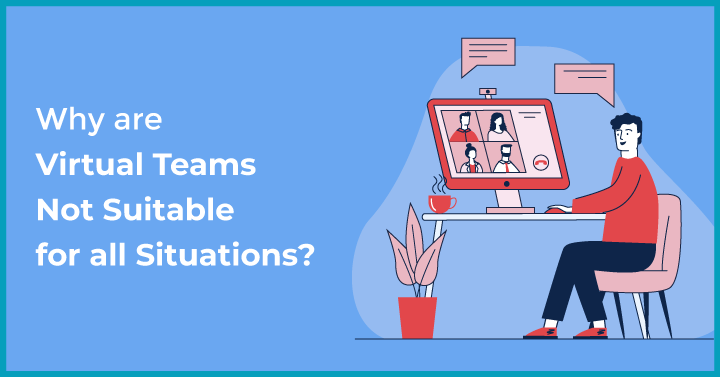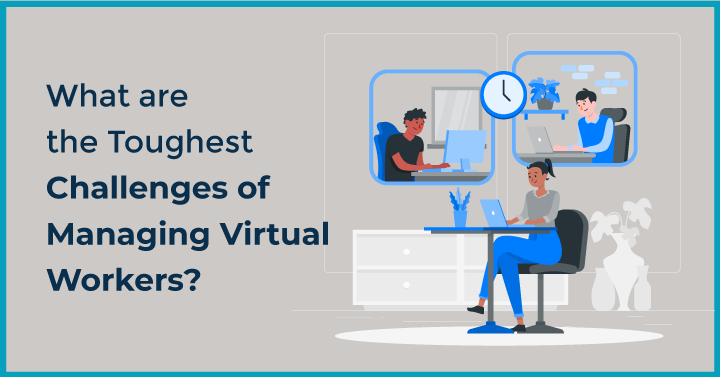1. Why are Virtual Teams Not Suitable for all Situations?
 You may think a virtual team is just another team. But there are differences that affect their ability to play to their strengths.Picture a sales representative in a discovery call or taking a lead through a product demo. Just when they’re getting to the good bit, the line cuts or the prospect complains of hearing background noises and echoes. Not the impression you were hoping your client-facing team would make, right? Put simply, virtual teams aren’t the best choice if the line of work requires a high-level of organization and coordination. There are many reasons why virtual teams fail in these situations.One, members in virtual teams aren’t all in the same place or time zone. Depending on which part of the world they’re living in, it can take time for someone to get back to you on an update. Such delays become a bottleneck if someone needs to sign off on a critical action or decision. Two, some members can experience frequent power cuts and technical glitches which are annoying enough as it is. But it's a bigger problem when it gets in the way of the business trying to be responsive, visible and supportive. Three, communication, both verbal and written, can be misconstrued if it's not contextualized, relevant and standardized.Let’s go into virtual team failures a bit more by understanding the downsides to a virtual-only workforce.
You may think a virtual team is just another team. But there are differences that affect their ability to play to their strengths.Picture a sales representative in a discovery call or taking a lead through a product demo. Just when they’re getting to the good bit, the line cuts or the prospect complains of hearing background noises and echoes. Not the impression you were hoping your client-facing team would make, right? Put simply, virtual teams aren’t the best choice if the line of work requires a high-level of organization and coordination. There are many reasons why virtual teams fail in these situations.One, members in virtual teams aren’t all in the same place or time zone. Depending on which part of the world they’re living in, it can take time for someone to get back to you on an update. Such delays become a bottleneck if someone needs to sign off on a critical action or decision. Two, some members can experience frequent power cuts and technical glitches which are annoying enough as it is. But it's a bigger problem when it gets in the way of the business trying to be responsive, visible and supportive. Three, communication, both verbal and written, can be misconstrued if it's not contextualized, relevant and standardized.Let’s go into virtual team failures a bit more by understanding the downsides to a virtual-only workforce.2. Cons of a Virtual Workforce

2.1 Harder to huddle
The downside to having employees in different locations as opposed to everyone in the same place, is that you no longer have direct visibility into happenings. In a collocated workspace, you can go up to the person’s desk, get everyone together for a team huddle or ask for an update through a hallway conversation. But the same is hard to replicate online because everyone needn’t be available or free when you need them. You’d have to work out a time that suits members before scheduling meetings. For this, it's important to train everyone (including yourself) to be adept at audio and video conferencing platforms.2.2 Harder to engage consistently
Consistency is key when it comes to keeping remote workers connected, engaged and communicative. It's easier said than done though, because in reality, work takes precedence and most conversations center around giving or receiving updates.Everyone’s familiar with the phrase, All work and no play makes Jack a dull boy. And that’s what the team will be heading for if companies aren’t intentional about engaging their employees after they’re onboarded. The other challenge to engagement is that employees are now a one-person army. Besides being accountable for output, they have to troubleshoot issues, set up their tech with remote assistance, help each other out and revert to mails. After all this, they’re also expected to have the stamina to attend back-to-back meetings as and when the occasion calls for it. This is one of the biggest reasons why why virtual teams fail.2.3 Establishing a supportive network
It's harder to get everyone to follow a culture structured around trust, support and encouragement when the team isn’t in contact with each other on a daily basis. You may unintentionally forget a coworker’s birthday or work anniversary, or be unable to organize fun Fridays that everyone can join in on. As a result, everyone defaults to a state where it's all about work. Without mini breaks to recharge, productivity tanks because employees lose focus. You will have to be creative in building a symbiotic network with the right incentives.2.4 Less cohesive
It is not possible to call a meeting of the entire organization to deal with a crisis. And yet, you cannot move forward without averting a situation that adversely impacts everyone. For example, tech issues such as server downtime can take up the better part of your work hours and prevent you from completing what you needed to do.2.5 Reputation risks
Potential customers are less likely to trust a fully virtual office and may not consider your firm to be a “real” business unless you are intentional about building trust from a distance.2.6 Legal complications
If your remote team comprises people working out of different countries, you’d have to learn about employment laws, hiring practices, tax rules etc for different locations. A centralized HR platform can help you out to a great extent by providing information before, during and after an employee is hired remotely.2.7 Security issues
Unless you use remote employee monitoring software, you won’t know if your employees are accessing sites or apps that are a security threat to your business. Such a tool can verify websites, block harmful apps, track activities, maintain logs and monitor productivity. You will, of course, need to get your employees’ consent and make them aware of what will and won’t be monitored.3. What are the challenges of managing virtual teams?

3.1 Lack of Direction Or Ambiguity in Structure
Ambiguity arises for one of three reasons- Expectations conveyed change later.
- Priorities are unexpectedly pushed up or moved back.
- Concerned staff are left out of decisions regarding their work, resulting in a breakdown in the chain of communication.
3.2 Improper Process definition
Process inefficiencies slow employees down, and in turn, their performance. It's important to remember that remote teams are now largely self-reliant. The only form of support and information they have is through online interactions with the right people. Getting timely help and access to resources, documents and material can help virtual workers combat their problems.3.3 Ineffective leadership
A manager can manage only when they are prepared and equipped. But most managers have been thrust into remote management, and the transition is missing the training that would have enabled them to lead and manage their virtual team. As a result, there is a lack of structure that makes it harder for employees to remain visible, present and accountable. According to an HBR study, 40% of the 215 managers surveyed expressed low self-confidence in their ability to manage workers remotely.3.4 Selective communication
Selective communication siloes teams because everyone relevant to a task, function or activity isn’t kept informed uniformly. Whether or not it's unintentional, leaving people out creates misunderstandings, trust issues and a wedge to form between workers.Work slows down when selective communication escalates. Teammates are no longer sure of what they and their coworkers are accountable for, or who they are answerable to. This uncertainty also impacts people’s ability to meet deadlines and deliver what’s expected.3.5 Geographic or language barriers
Communication gets lost in translation when there are language or geographic barriers or even a difference in accents. The virtual team will need to be trained on cultural sensitivity to make sure that how they converse makes sense to the intended teammate.3.6 Absence of right tools to do the work
We’ve all experienced uncooperative technology, from screens that freeze when presenting to frequent dropouts from ongoing calls. And it's frustrating to be on either side of this. Incompatible or outdated software, faulty and slow equipment impacts a remote employee’s ability to access and work with content online. The absence of the right tools and software prevents them from staying in sync with the remaining team members.3.7 Distractions in work and home environments
In a physical office, everyone is in the same setting, which means there’s a predictability, even to distractions. You can get a measure of the type of distraction and when it's likely to occur. When everyone’s working at home, the distractions vary and are subjective to individual environments. For example, working parents have caregiving responsibilities, as opposed to a virtual employee who stays independently or with housemates and friends. With a unified calendar for professional and personal work, either can get in the way of the other.3.8 Slow response times
Virtually, messages can go unread when a team member has their head down in work and misses the notification, or is away from their desk. This leads to slow response times. In a physical office, you can confirm what individuals are up to but when you’re distanced, there can be any reason for a colleague’s delayed response. This is a big reason why are virtual teams not suitable for all situations-.3.9 Lack of engagement at work
Although 90% of remote workers love the flexibility that comes with working anywhere they please, the downside reported is that working with others proves more challenging. Virtual employees struggle to establish their presence online and as a result, some end up feeling shut out of major decisions and come to know about it much later.The lack of engagement can cause morale to run low amongst members.3.10 Weak training techniques
An HBR study that surveyed remote respondents reported that 46% of successful managers check in frequently and consistently. Only such managers can claim to know their team well. One area that managers are responsible for is ensuring that their teams avail professional development opportunities. Without the training, your workforce’s skills continue to remain outdated and at risk of going obsolete. Remotely, however, it is difficult to truly get a read of a person’s interest and the e-learning programs or remote training courses that are relevant and useful.4. Tips to Overcome Virtual Team Failures

4.1 Hire the right candidate
If you’re keen to prevent virtual team failures, you have to start by hiring the right candidate. Recruiting hinges on understanding the position you’re trying to fill, and the skills, temperament and cultural fit of the potential candidate. If one or all three qualities are missing, it becomes a mismatch. For example, a highly skilled employee with bullying tendencies can be difficult for the others on the team to work with. Therefore, stringent measures should be taken to hire and onboard the right candidate.Each role’s required skills and experience should be clearly mentioned in job portals and networking sites. Your remote work culture should be highlighted in the answers you provide to questions the interview candidate asks. This way, they too get a measure of how your company works, what you’re looking for in them and what your beliefs, goals and principles are. In simple words, hiring is a two-way street, both the applicant and HR team should be able to give and obtain sufficient information about each other in order to decide if it's a mutually strategic fit.4.2 Start with proper onboarding
Remote employee onboarding is different to onboarding a person in an office. It's imperative to organize personnel files and sort out the documentation to be sent out. It's also helpful to clue new joiners in on what to expect on their first day and to provide a point of contact within HR and the department they’ll be part of. Take care to also inform the current team and department of the recruit’s joining date so that they can make themselves available for an online introduction. Ask around to find out who has administrator or master access to chat groups and channels that the new joiner will need to be added to. This will enable them to participate and contribute to discussions.4.3 Set expectations early
Base your expectations for performance on realistic, time-bound and achievable goals. Once you set your expectations regarding work accountability, you need to standardize the means through which you convey them. I personally find it useful to have a reach out process, where the first step is to leave a message on either Slack or Samepage, and then schedule a brief call to go over the work for the week. I also follow it up with a mid-week catch up to see how everyone is tracking for work. Following a process to convey your expectations helps people keeps priorities within sight, and enable them to be more productive throughout the week and nip challenges of virtual team meetings the bud.4.4 Hold clear communications
Structured communication makes a world of a difference in a virtual office. It prevents virtual team failures by encouraging everyone to contextualize conversations. This ensures that every one relevant is in attendance when important updates and announcements are passed around.4.5 Regular meetings for a status check
Managers should hold frequent and consistent catch-ups with members, both as a group and on a one-on-one basis. Depending on the troubles members are having, they may prefer to speak to you privately for guidance on the matter. Once you know what the issue is, you can work together to resolve it and put it to rest.These status checks work in favour of the manager in question, too. It sustains the rapport you’ve worked hard for and lets the team know that you’re not just there to delegate work and leave them to their own devices. In a way, it's an opportunity for managers to find out how their team is faring, the things they are doing right as well as wrong. This helps you stay objective when appraising their performance. People are also more likely to be honest and upfront in regular checks when they know that their managers are empathetic and intentional about helping them bring out their best at work. Challenges of virtual team meetings can be easily managed if there is a set procedure followed.5. What are the Toughest Challenges of Managing Virtual Workers?
 Some of the toughest challenges of managing virtual workers includea. Mismanagement of resources, time and funds
b. Communication breakdowns or
c. Misfits, or the classic case of ‘square pegs in round holes'Managers or team leads are the glue that holds the team together. Take a step back to reassess how you broach communication, setting deadlines and expectations. This is where you have a chance to correct process inefficiencies.Leveraging the right remote collaboration and management tools helps managers in keeping the team cohesive. It keeps the schedule visible and enables members to work towards both shared and individual goals. Overall, a successful virtual team includes team members who are prepared and ready for the transition.The right person helming the team can ensure it runs like a well-oiled machine, with members who pool in their knowledge and insights, and who get along with each other. Don’t fail the team if you don’t want virtual team failures!
Some of the toughest challenges of managing virtual workers includea. Mismanagement of resources, time and funds
b. Communication breakdowns or
c. Misfits, or the classic case of ‘square pegs in round holes'Managers or team leads are the glue that holds the team together. Take a step back to reassess how you broach communication, setting deadlines and expectations. This is where you have a chance to correct process inefficiencies.Leveraging the right remote collaboration and management tools helps managers in keeping the team cohesive. It keeps the schedule visible and enables members to work towards both shared and individual goals. Overall, a successful virtual team includes team members who are prepared and ready for the transition.The right person helming the team can ensure it runs like a well-oiled machine, with members who pool in their knowledge and insights, and who get along with each other. Don’t fail the team if you don’t want virtual team failures! Interested in Virtual Team Building Events?
Interested in Virtual Team Building Events?





















